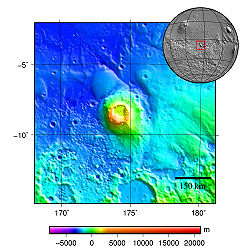 Topography map of Apollinaris Mons | |
| Feature type | Shield volcano |
|---|---|
| Coordinates | 9°18′S174°24′E / 9.3°S 174.4°E [1] |
Apollinaris Mons is an ancient shield volcano in the southern hemisphere of Mars. It is situated near the equator, south of Elysium Planitia and north of the impact crater Gusev (the landing site of the Mars rover Spirit ). Elysium Planitia separates it from the volcanic province of Elysium to its northwest. The volcano's caldera is named Apollinaris Patera; [2] this name formerly applied to the whole edifice.
Contents
Apollinaris Mons is about 5 kilometres high with a base about 296 kilometres in diameter. [3] [ better source needed ] On the top of this volcano is a caldera about 80 km (50 miles) in diameter. The volcano is approximately 3 billion [4] to 3.5 billion years old. [5]
It was named in 1973 after a mountain spring near Rome in Italy.[ citation needed ]
A study using a global climate model found that the Medusae Fossae Formation could have been formed from ash from Apollinaris Mons, Arsia Mons, and possibly Pavonis Mons. [6]
